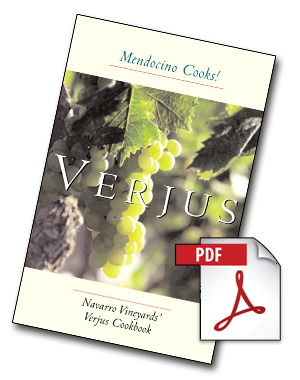Verjus was discovered in the Middle Ages as a way to acidify foods, especially if you lived in the part of Europe that could grow grapes but not lemon trees. The berries in a grape cluster are hard at 10° or 11° Brix with no extractable juice; at 12° or 13° Brix they start to soften and can be harvested with maximum acidity for Verjus. We use Verjus at home as a replacement for vinegar or lemon juice—since the acid is malic rather than citric, the Verjus flavor is apple-like. This vintage of verjus was produced from first-crop Pinot Noir grapes and the juice has a blush from the Pinot skins. Refrigerate after opening; verjus is typically delicious for several weeks and can also be frozen in an ice-cube tray for longer term use.
 If you would like some recipes of how verjus is used in cooking, please download a PDF recipe booklet.
If you would like some recipes of how verjus is used in cooking, please download a PDF recipe booklet. ![[right]](/images/buttons/arrow_right.gif)

